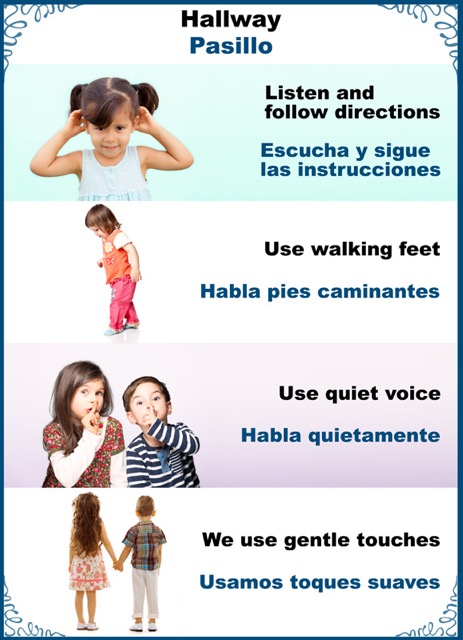What strategies can teachers use to support these children?
Page 6: Use Visual Supports
 One of the simplest and most direct ways professionals can support young DLLs with disabilities is through the use of visual supports. Visual supports come in the form of photographs, drawings, symbols, labels, manipulatives, real objects, and other supplemental images. Visual supports can:
One of the simplest and most direct ways professionals can support young DLLs with disabilities is through the use of visual supports. Visual supports come in the form of photographs, drawings, symbols, labels, manipulatives, real objects, and other supplemental images. Visual supports can:
- Facilitate children’s learning of new skills
- Help children understand what they need to do and where things belong
- Assist children in understanding and following the day’s schedule and routines
- Be helpful when breaking down tasks, routines, and skills into simpler steps (e.g., the steps to washing hands)
- Enhance children’s understanding of the content and vocabulary introduced in the classroom
Professionals must be intentional—that is, purposeful and thoughtful—when they introduce visual supports, particularly in association with new words and concepts. It is important that visual supports incorporate images and language familiar to the child (e.g., photos of common household items). In addition, teachers should label important items in both the children’s home language and in English.
Irlanda Jimenez discusses using visual supports for young DLLs in the classroom (time: 2:01).

Irlanda Jimenez
Multicultural Coordinator, Bilingual/ESL Teacher
Urbana Early Childhood Schools
Transcript: Irlanda Jimenez
First of all, providing visuals for the child so that they are able to communicate non-verbally, if that’s where they’re at. If I’m doing a story and I’m going to be asking a question, what can I do as a teacher so that my DLL student can also participate? The more concrete you can make your examples, the better. If you’re developing a unit or a theme, make it something that is concrete, something that the child might have experience with. If they don’t have experience with it, giving them that background knowledge so that they are familiar with it. For example, if you’re doing something on firefighters, sometimes our culminating activity might be the field trip to the fire station. But with our DLLs, it’s more helpful for them in building that background knowledge to do the field trip at the beginning. When you’re saying, “fire truck,” they can actually see a real fire truck. We start talking about, “The firefighter slides down the pole.” Well, what does that mean? You kind of show it in a picture, and it may just look like someone on a pole, but are they seeing that sliding down the pole what you’re trying to convey? So I think definitely concrete examples and being able to touch it, being able to see it. If you can’t go there then with videos and so forth, giving kids a chance to see something or maybe even providing some of the materials in the native language, so that that way parents could also support what you’re teaching within the classroom. Within visual supports, they could be props that you use while you’re reading a story. If you’re talking about pumpkins, having a real pumpkin, having kids experience taking the seeds and the pulp, so when you’re saying “pulp,” when you’re saying “seeds,” when you’re saying “squishy,” they get a chance to see that.
A look inside Mrs. Raymond's classroom
Several children in Mrs. Raymond’s class are unfamiliar with many of the foods described in The Very Hungry Caterpillar. In response, Mrs. Raymond brought in some of the food from the story so that the children can see and taste them. Children can also share about the foods they eat at home when reading this story. Mrs. Raymond adds pictures in the dramatic play area so children can practice learning the new vocabulary.